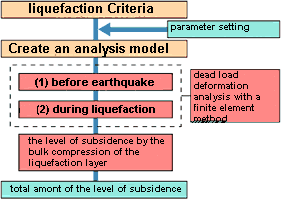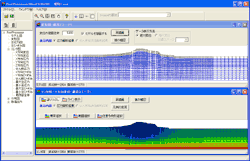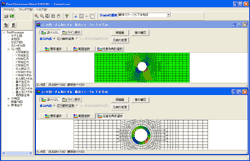
| gVersion Corresponding to the 2007 Guidelines for Quake-Resistance Testing of River Structures (draft)h |
We would like to introduce "GeoFEAS 2D Ver2.0", which is currently under development.
This version officially supports the "2007 Guidelines for Quake-Resistance Testing of River Structures (draft)".
Many of the existing wide-span levees are historic structures, and they were repeatedly reinforced one by one over a long period of time, and expansion of the levees and the sectional security are well maintained. However, the developments of such structures were based on such experience as disaster, and it has not been designed with analytical consideration of fracture process of the structure. As the anti-flood control measures develop, it becomes clearer that more people and assets are in the flood plain, and the security of levees becomes more and more important. The guidance states that with such background, systemization of levee design for engineering is required, and the current way of thinking about the levee design is noted down in the guidance.
This part describes the ways to set earthquake motion settings or method of testing quake-resistance that are necessary for the quake-resistance checks for river structures. It is assumed that a method for quake-resistance test is classified roughly into dynamic method and static method, but the former generally models the phenomenon in an earthquake precisely, and requires detailed input data and highly technical judgment. This guidance simplifies the phenomenon and assumes the static method, which is comparatively easy to model. Table 1 is the comparison the dynamic and static methods. For reference, UWL is incorporated as analysis code of the "dynamic effective stress analysis of the ground (UWLC)" which is one of our products in ground analysis series.
| A dynamic finite element method based on effective stress | |
| LIQCA | A method using the theory of elasto-plasticity, based on effective stress. Taking into consideration the creation of excess hydrostatic pressure and stiffness reduction in an earthquake, deformation of the ground can be calculated by a time history. The water permeation phenomenon of the ground is also considered. |
| FLIP | The method combining the excess hydrostatic pressure model and the model that considers the relationship between the shearing stress and the shearing deformation, assuming that the simple shear is in the arbitrary direction. The incidence of the excess hydrostatic pressure in an earthquake, deformation of the ground can be calculated by a time history. |
| UWL | A method by the elasto-plasticity theory based on the effective stress. Taking into consideration the incidence of the excess hydrostatic pressure in an earthquake and the reduction in stiffness, deformation of the ground can be calculated by a time history. The water permeance phenomenon of the ground is also considered. |
| Analysis of subsidence caused by the dead load of the ground by a static finite element method | |
| ALID | Evaluation by linear static finite element method, assuming that fluidity caused by liquefaction as a slowly occurring post-liquefaction phenomenon. The stiffness reduction in the liquefaction can be evaluated by liquefaction criterion (FL method). |
| Permanent deformation analysis based on energy principle | |
| Towhata model | A method to calculate the amount of displacement by the dead load after the liquefaction based on the minimum energy principle. The liquefaction layer is assumed to be a viscose fluid and a non-liquefaction layer is assumed to be an elastic body resisting the transverse deformation. |
In addition, the shear stiffness ratio for the initial effective confining pressure, FL (liquefaction resistance ratio) and RL (cyclic triaxial strength ratio) are illustrated as "handling of a liquefying soil layer" in the previous section. Liquefied soil can be expressed as the convexity down bilinear model: when shear distortion become increase, shear stiffness suddenly recover. (cf. seismic guidance, fig 6.3.1). One of major features of GeoFEAS2D is the introduction of this new constitutive equation.
Level 2 earthquake motion, which is assumed to cause critical outcomes, is to be considered as the earthquake motion in the quake-resistance checks for levees. GeoFEAS 2D will be used for "the deformation analysis of the foundation ground".
The liquefaction criteria of the sandy soil layer shall be by the rule of 6.2 in the second section of this article. As mentioned above, the sandy soil layer which is judged as liquefaction (hereinafter called "liquefaction layer"), it should be note that when the soil layer, which is judged to be the upper part of the liquid layer, will be in the state of liquefaction, the change of the property of the soil layer on surface layer of the liquefaction needs to be considered. the following steps are needed for the checking of the levee. First, consider the properties of the soil layer after the liquefaction and then with the method which can calculate the deformation of the levee statically, check the height of the levee after earthquake; whether it is less than the outside water level, which is ruled by 2.2 of the second section of this article of the seismic performance checking.
Although the guidance describes that the easy and accurate methods to statically calculate the deformation of the levee caused by the liquefaction assumes that the soil layerfs stiffness will be reduced by the liquefaction, the dead load acts as an earthwork, and calculates the deformation with a finite element method (the dead load analysis with a finite element method) as well as the measure which assumes the liquefaction as a viscous fluid without shear resistance, and calculate the fluid deformation of the ground, GeoFEAS2D adopts the former alternatives.
Figure 1 shows in detail the deformation analysis part of the foundation ground. The dead load deformation analysis with a finite element method includes:
- deformation analysis before earthquake (before liquefaction)
- deformation analysis after earthquake (during liquefaction).
The difference between (1) and (2) is the level of displacement caused by the liquefaction. Above analysis method doesn't consider (3) the level of subsidence (deformation analysis) caused by the bulk compression of the liquefaction layer. Therefore, to calculate the total displacement level of the levee, it is necessary to calculate (3) separately and then add it. Therefore, above three cases, (1) (2) and (3) will be analyzed in GeoFEAS2D.
Figure 2 shows the deformation diagram of the dead load deformation analysis result (Post display diagram).
 |
 |
|
We are considering linking "GeoFEAS 2D Ver.2" with our "Flexible Structure Sluiceway Design" to enable level 2 earthquake motion tests to be carried out in single chain.

